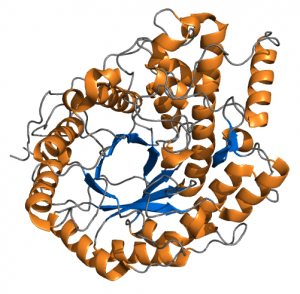 This is the third installment in my Enzymes for Brewers series. This article contains information for those interested in background material on enzymes, but none of it is specifically relevant to brewing. I will (finally) get into some general issues relevant to enzymes in brewing in my next two articles on enzyme kinetics. (These are already written, and I’ll post them Thursday and Friday.) In my final article in this series, I will review the relevant enzymes in brewing, what is known about them, and what this means to us as brewers. But first, given the complexity of the topic, let’s quickly review what was covered in previous articles.
This is the third installment in my Enzymes for Brewers series. This article contains information for those interested in background material on enzymes, but none of it is specifically relevant to brewing. I will (finally) get into some general issues relevant to enzymes in brewing in my next two articles on enzyme kinetics. (These are already written, and I’ll post them Thursday and Friday.) In my final article in this series, I will review the relevant enzymes in brewing, what is known about them, and what this means to us as brewers. But first, given the complexity of the topic, let’s quickly review what was covered in previous articles.
Review
Catalysts speed the rate of a chemical reaction that is already bound to occur. Enzymes are biological catalysts. They are usually proteins, which are linear strands of amino acids. Most proteins that are enzymes are folded into a globular three-dimensional shape. Their shape includes a pocket or cleft called an active site, which is where the enzyme binds the substrate.
The enzyme then catalyzes the reaction. This can occur in many ways, including bending or twisting the molecule to break a bond, placing two molecules in physical proximity so they react, rearranging electrons around the substrate to weaken or break bonds, etc. (See the previous articles, covering catalysts and proteins, and enzyme function, for more detail. For much more detail, click the links within this paragraph to be directed to the Wikipedia pages covering these concepts.)
Control of Enzymes
In the cell, enzymes are controlled by many methods. Cells can produce more enzymes when needed. Jacob and Monod, starting in the 1950s, were the first show how this might be possible. Their work showed that the set of genes that produces the enzymes that metabolized the sugar lactose were shut off when lactose was not present. A protein called the lac repressor was bound to the regulatory part of that set of genes so that the DNA would not be transcribed into RNA. (The lac repressor physically blocked the cellular machinery that transcribes RNA from DNA from transcribing those genes.) When lactose was present, it bound to the lac repressor, releasing it so that the genes could be transcribed. When all the lactose was metabolized, the repressor would again bind to the control region, shutting off the genes.
Some enzymes only work when they are bound to a specific activator. Conversely, cells can inactivate certain enzymes by producing inhibitors. This is called allosteric regulation. The inhibitors can later be destroyed by other enzymes, activating a pool of enzymes within the cell.
Some enzymes exist in a nonfunctional state until they are modified by another enzyme. The modifying enzyme may add a chemical residue to the inactive enzyme or cleave off part of its amino acid strand. The enzyme will then change shape, revealing its active site. A well-known example of this is the enzyme chymotrypsin. This is a digestive enzyme, a protease (meaning it cleaves proteins). An inactive form of the enzyme, called chymotrypsinogen, is produced in the pancreas so that the active form does not digest tissues in the pancreas or in the ducts leading to the duodenum, where it becomes active. (The duodenum is the part of the small intestine immediately following the stomach.) Once it reaches its destination, it is cleaved by an enzyme called trypsin to produce the active form of the enzyme.
Finally, an enzyme may only become active when it reaches the appropriate part of a cell – within an organelle or bound to a membrane. For example, permeases are membrane-spanning proteins that regulate what cells take in. For example, the enzyme lactose permease lets bacteria take lactose into their cells. In the cytoplasm (the liquid inside the cell), permeases have no function. However, when they insert themselves into the cell membrane, they attain their active shape and are then able to perform their task.
In brewing, you don’t need to worry about any of this. The cells in the barley malt are no longer alive, as they do not survive drying and kilning during malting. As a brewer, you simply need to dissolve the starch, proteins, gums — and the existing enzymes — into the mash. In the next installment in this series, I will discuss the effect of concentration of the substrate and enzyme on the rate of reactions in the mash.
—
Related articles

Speak Your Mind